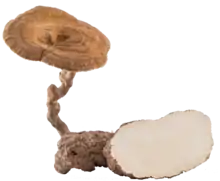| Lignosus rhinocerus | |
|---|---|
 | |
| Scientific classification | |
| Kingdom: | |
| Division: | |
| Class: | |
| Order: | |
| Family: | |
| Genus: | |
| Species: | L. rhinocerus |
| Binomial name | |
| Lignosus rhinocerus | |
| Synonyms[1] | |
Lignosus rhinocerus, commonly known as tiger milk mushroom, belongs to family Polyporaceae in the division Basidiomycota.[2][3][4] This fungus is geographically distributed only in tropical rainforests in the region of South China, Thailand, Malaysia, Indonesia, Philippines and Papua New Guinea.[5][6]
In Malaysia, the tiger milk mushroom is more often known as "Cendawan Susu Rimau". It has been used in traditional medicine.
History
The tiger milk mushroom was first reported in the West in 1664 when a European government agent was given this product upon sailing to the South East Asian Region. According to The Diary of John Evelyn (Publication dated 22 June 1664), this mushroom was named ‘Lac tygridis’, meaning "tiger’s milk". In his publication, Evelyn also recorded that this fungus was used by the local people to treat diseases for which European doctors found no cure. In 1890, Sir Henry Nicholas Ridley, the father of Malaya’s rubber industry, recorded that this fungus was an important medicinal mushroom used by local communities.[7] He even attempted to cultivate it but failed. In the same year, this fungus was scientifically documented by Mordecai Cubitt Cooke who named it as Fomes rhinocerotis based on a specimen found in Penang.[8] Today, it is known by the scientific name Lignosus rhinocerus.
Micological description
Lignosus rhinocerus has a centrally stipulate pileus, meaning a mushroom cap which grows at the end of a stipe (stem) arising from a buried tuber or sclerotium.[9] Their growth is solitary, and typically only one fruit body can be found at a time.
Claimed benefits
A 2018 review of the testing of investigations into Lignosus rhinocerotis concluded that "there is a paucity of validation studies including human clinical trials of the mycochemicals of L. rhinocerotis."[10]
Aboriginal people boil it with Tongkat ali to be used as general tonic.[11]
Research
Research findings have revealed that tiger milk mushroom sclerotia contain various phytochemicals, such as polysaccharides, polysaccharides-protein complexes, and β-glucan.[12]
Cultivation
The mushroom was successfully cultivated using solid fermentation technology.[13]
References
- ↑ "GSD Species Synonymy: Lignosus rhinoceros (Cooke) Ryvarden". Species Fungorum. Kew Mycology. Retrieved 2016-11-10.
{{cite journal}}: Cite journal requires|journal=(help) - ↑ Ryvarden, L. and Johansen, I. 1980. A preliminary polypore flora of East Africa. Fungiflora. Oslo. 1–636.
- ↑ Douanla-Meli C, Langer E. (2003). "A new species of Lignosus (Polyporaceae) from Cameroon". Mycologia 86: 389–94.
- ↑ .Tam CS, Ng S-T, Tan J. (2013). "Two new species of Lignosus (Polyporaceae) from Malaysia — L. tigris and L. cameronensis". Mycotaxon 123: 193–204. doi:10.5248/123.193.
- ↑ Núñez, M. and Ryvarden, L. 2001. East Asian polypores 2. Polyporaceae s. lato. Synopsis Fungorum 14: 170–522.
- ↑ Cui, B.K., Tang, L.P. and Dai, Y.C. 2010. Morphological and molecular evidences for a new species of Lignosus (Polyporales, Basidiomycota) from tropical China. Mycologia Progress 1–5.
- ↑ Ridley, H. N. (1890). . Journal of the Straits Branch of the Royal Asiatic Society. Vol. 22. pp. 341–344 – via Wikisource.
- ↑ Cooke.1879.'XV.Enumeration of Polyporus [J].Transactions and Proceedings of the Botanical Society of Edinburgh,13(1):131–159.
- ↑ Ryvarden, L. and Johansen, I. 1980. A preliminary polypore flora of East Africa. Fungiflora. Oslo. 1-636.
- ↑ Nallathamby, Neeranjini; Phan, Chia-Wei; Seow, Syntyche Ling-Sing; Baskaran, Asweni; Lakshmanan, Hariprasath; Abd Malek, Sri N.; Sabaratnam, Vikineswary (15 January 2018). "A Status Review of the Bioactive Activities of Tiger Milk Mushroom Lignosus rhinocerotis (Cooke) Ryvarden". Frontiers in Pharmacology. 8: 998. doi:10.3389/fphar.2017.00998. PMC 5775285. PMID 29379443.
- ↑ (Chang, Y.S. and Lee, S.S. (2001). Utilization of wild mushrooms by the Temuans in Selangor,Malaysia. Poster presented at CFFPR 2001, 100 Year Celebration of Forestry Research, 1-3 Oct 2001, Nikko Hotel, Kuala Lumpur.)
- ↑ Lau, B.F.; Abdullah, N.; Aminudin, N.; Lee, H.B.; Tan, P.J. (2015). "Ethnomedicinal uses, pharmacological activities, and cultivation of Lignosus spp. (tiger׳s milk mushrooms) in Malaysia – A review". Journal of Ethnopharmacology. 169: 441–458. doi:10.1016/j.jep.2015.04.042. PMID 25937256.
- ↑ Tan C S, Ng S T, Vikineswary S, et al. 2009. Development of Lignosus rhinocerus (Cendawan Susu Rimau) cultivar-Bring to life to a valuable Malaysian medicinal mushroom [M] . International Congress of Malaysian Society for Microbiology ( ICMSM 2009) . Penang, Malaysia.